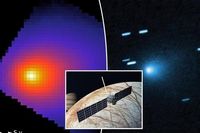Two space probes, currently racing through the solar system, are on the brink of making history by intercepting the tail of a mysterious, Manhattan-sized comet—if scientists can act quickly enough. The comet, dubbed 3I/ATLAS by NASA, has been the subject of intense scrutiny and speculation ever since its discovery in June 2025. With its bizarre behavior and unusual composition, 3I/ATLAS has ignited debates within the scientific community, some even suggesting it could be an intelligently-operated alien probe.
According to Live Science, the probes Hera and Europa Clipper are ideally positioned to pass through a dispersal field of particles trailing behind 3I/ATLAS, a rare opportunity that could allow researchers to gather unprecedented data from an interstellar object. The window for this maneuver is narrow—scientists have roughly two weeks from October 27, 2025, to adjust the probes’ trajectories and capitalize on this cosmic alignment.
3I/ATLAS is no ordinary comet. It is the largest, fastest-moving, and quite possibly the oldest interstellar object ever observed by humankind, as reported by The Economic Times. The object will reach its closest point to the sun, known as perihelion, on October 29, 2025, before commencing its months-long journey out of the solar system. During this critical period, the comet will be hidden behind the sun, making it impossible for telescopes on Earth to obtain a clear view. This makes the role of the space probes even more vital.
But what makes 3I/ATLAS so peculiar? For starters, it’s been ejecting a nickel alloy never before observed in nature—only in human manufacturing. According to LADbible, images captured by Spain’s Nordic Optical Telescope in September 2025 revealed the comet’s tail is composed of carbon dioxide, water, cyanide, and that enigmatic nickel alloy. This composition, combined with the comet’s irregular trajectory and behavior, has led some scientists, like Harvard astrophysicist Avi Loeb, to question its natural origins.
Loeb has been particularly vocal about the comet’s oddities. He pointed out the presence of an ‘anti-tail’—a jet of particles emitted from the comet’s front, seemingly pushing material toward the sun rather than away from it. “There were claims of a tail,” Loeb explained, “but since 3I/ATLAS is accelerating and its current size is not much larger than the angular resolution of Earth-based telescopes, it is not easy to avoid fictitious elongation of the image as a result of the object's motion.”
Yet, the story doesn’t end there. Loeb speculates that the tail’s sudden appearance could be evidence of a ‘braking thrust’ maneuver, a technique that might be employed by a technologically advanced object to slow itself down using the sun’s gravity—a process known as an Oberth maneuver. Writing on his blog, Loeb laid out a scale for interstellar objects: “I suggested a ‘Loeb Scale’ for interstellar objects where ‘0’ is definitely a natural object (comet or asteroid) and ‘10’ is definitely a technological object (identified by maneuvers or emission of artificial light or signals). Currently, I give 3I/ATLAS a 6 on that scale, but my assessment will change as we get better data on it when it comes closer to the Sun.”
Loeb didn’t mince words about the potential for a high-impact event, either. He estimated “a 30 to 40 percent likelihood that 3I/ATLAS does not have a fully natural origin,” and suggested that, in a low-probability scenario, the comet could represent a ‘black swan event’ akin to a Trojan Horse—where a technological object masquerades as a natural comet. Still, the International Asteroid Warning Network has emphasized that 3I/ATLAS poses no threat to Earth, but presents a “great opportunity” for scientific observation due to its prolonged visibility and high interest to the research community.
So, how might Hera and Europa Clipper fit into this cosmic drama? Both probes are currently on separate missions—Hera is en route to study an asteroid, while Europa Clipper is headed to analyze the icy surface of Jupiter’s moon Europa. However, a new paper in the Research Notes of the American Astronomical Society found that both spacecraft are perfectly poised to intercept the dispersal field of 3I/ATLAS, passing “downwind” of the comet as the sun’s solar wind carries particles millions of miles away. While neither probe will fly directly through the comet’s tail, they will traverse a region about five million miles from the nucleus, close enough to collect invaluable data on the particles shed by this cosmic visitor.
The urgency is real. As Live Science notes, scientists have a fleeting two-week window to issue course corrections and send the probes into the path of the comet’s debris. Hera, unfortunately, may not be able to contribute much; it isn’t equipped with instruments capable of analyzing the specific particles released by 3I/ATLAS. Europa Clipper, on the other hand, has precisely the kind of scientific tools needed for the job, making it the best bet for unlocking the comet’s secrets.
NASA’s James Webb Space Telescope has also joined the effort, observing 3I/ATLAS with its near-infrared spectrograph on August 6, 2025. These observations have provided additional insights into the comet’s composition, but the real breakthrough could come if Europa Clipper successfully samples the comet’s tail as it speeds toward Jupiter. The data could help scientists determine once and for all whether 3I/ATLAS is a purely natural phenomenon or something far more extraordinary.
While the prospect of an alien probe may sound like science fiction, the scientific community remains cautious. Mainstream astronomers generally agree that 3I/ATLAS is a comet—albeit a highly unusual one. But as Loeb and others have pointed out, the lack of a definitive explanation for its behavior leaves the door open, however slightly, to more exotic possibilities. The coming weeks will be critical, as researchers scramble to gather as much information as possible before the comet disappears from view.
In the end, whether 3I/ATLAS turns out to be a natural interstellar wanderer or something engineered by intelligence, its passage through the solar system has already provided a rare opportunity for discovery. The world now waits to see if quick-thinking scientists can seize the moment and send Europa Clipper into the cosmic debris, perhaps answering one of the most tantalizing questions of our time.




